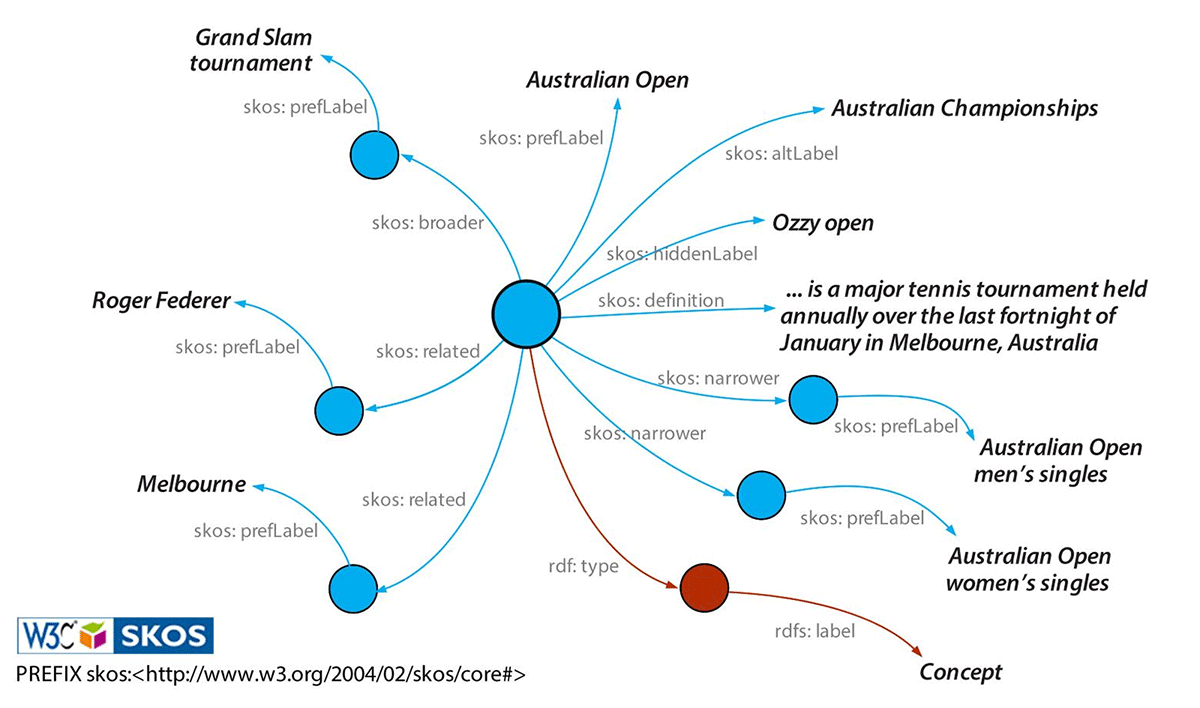PoolParty, SKOS, RDF and URIs
14/04/2025
PoolParty implements SKOS to create a hierarchical structure within the taxonomy. It is based on RDF. Each PoolParty concept (a SKOS property or class) has a URI.
This list of the most important SKOS classes and properties used by PoolParty is relevant for advanced users or programmers who need to work with the RDF representation of a project. We also give a very short introduction to the Semantic Web technologies behind SKOS. For more comprehensive information on the Semantic Web, please go to W3C's Data Activity and pick a presentation which fits your interests.
SKOS is based on the Resource Description Framework (RDF) which is one of the fundamental Semantic Web specifications. It was developed within the W3C standards framework. RDF uses graphs as its data structure. This means that each concept is a node and edges connect these nodes to create a graph.
The image below displays data of a thesaurus presented as a graph. The graph has the concept 'Australian Open' as its central node. Several edges connect this node to its labels and definition as well as to other nodes. All edges are typed, thereby indicating which kind of relationships exist between the nodes they connect, e.g. the node 'Australian Open men's single' is connected to the node 'Australian Open' via skos:narrower. The edges are called 'properties' in RDF. They can also connect a node with a literal, in the case of SKOS these are the labels, definitions or scope notes.

Each statement in RDF encodes information as 'triples'. A triple always has the form subject > predicate > object, e.g. 'Australian Open men' single' > skos:narrower > 'Australian Open'. Each property and class in SKOS and each concept in PoolParty has a uniform (unique) identifier, also called URI. In the case of SKOS these are always HTTP URIs, in the case of PoolParty they can either be URNs or HTTP URIs. The complete URIs of SKOS properties or classes can be formed by expanding the namespace prefix 'skos:' which is just a shortcut for the base URI http://www.w3.org/2004/02/skos/core#.
The following table shows elements from the SKOS definition used by PoolParty:
PoolParty | SKOS |
|---|---|
Classes | |
Concept Scheme (e.g. a thesaurus) | The SKOS counterpart for a PoolParty concept scheme is skos:ConceptScheme. |
Top Concept/Concept | In SKOS both are represented by the same class, namely skos:Concept. A top concept is connected to a concept scheme (thesaurus) via the skos:hasTopConcept/skos:topConceptOf relation. |
Collection | Represents a skos:Collection. Collections are labeled groups of concepts. A concept becomes part of a collection via the skos:member relation. |
Lexical properties | |
Preferred Label, Alternative Label, Hidden Label | skos:prefLabel, skos:altLabel, skos:hiddenLabel are used to add lexical labels to concepts. |
Relation properties | |
Concept In Concept Scheme | skos:inScheme indicates the concept schemes a concept is part of. |
Top Concept Of / Has Top Concept | skos:topConceptOf and skos:hasTopConcept is used to specify the semantic relation between the concepts on the 1st level of the hierarchy and the concept scheme. |
Broader/Narrower, Related | skos:narrower, skos:broader and skos:related are used to create semantic relations between concepts. |
Exact Match, Close Match, Broader Match, Narrower Match, Related Match | skos:exactMatch, skos:closeMatch, skos:broadMatch, skos:narrowMatch and skos:relatedMatch are used to create semantic relations to Linked Data Enrichment with PoolParty, or to Link Matching Concepts in Different Projects and may be used to create relations between concepts in different concept schemes |
Documentation properties | |
Scope Note, Example, Definition | skos:scopeNote, skos:example and skos:definition are used to add information about the meaning and the use of a concept. |
Editorial Note, History Note, Change Note | skos:editorialNote, skos:historyNote, skos:changeNote are used to add information about the maintenance, the history and changes made to a concept. |
Notation properties | |
Notation | skos:notation is used to add a classification code to a concept. |
Note
A PoolParty project has no counterpart in SKOS. It is a PoolParty specific container, used to group concepts schemes, in PoolParty concept schemes are equated with thesauri. For more information, see: SKOS and PoolParty, PoolParty Project.
PoolParty uses more classes and properties from SKOS and also other schemas and ontologies than those listed above. Further details about this goes beyond the scope of this manual, so we restrict the list to the most important classes and properties for describing thesauri, which are also used in the other examples in this manual.
Semantic technologies open up the possibility to use an RDF reasoning engine on thesauri to draw inferences, e.g. since narrower and broader relations can be transitive, a reasoner could list all narrower concepts of their parent as being also narrower concepts of their grandparents, e.g. broader concepts of 'Australian Open men's single' are 'Australian Open' as well as 'Grand Slam tournament'. For more information, see: Working With Concept Schemes and Concepts, Managing Your Thesauri.
Tip
If you would like to learn more about this feature, you can sign up for the PoolParty Academy and try it out or watch this PoolParty Academy Tutorial video: